ISS: SpaceX CRS-24 (International Space Station: SpaceX Commercial Resupply Service -24 Mission)
Non-EO
NASA
Mission complete
Quick facts
Overview
| Mission type | Non-EO |
| Agency | NASA |
| Mission status | Mission complete |
| Launch date | 21 Dec 2021 |
| End of life date | 24 Jan 2022 |
ISS: SpaceX CRS-24 (International Space Station: SpaceX Commercial Resupply Service -24 Mission)
Launch
The CRS-24 (Commercial Resupply Services) mission was launched on the SpaceX Dragon spacecraft on 21 December 2021 at 10:07 UTC (5:07 a.m. EST) using a Falcon 9 launch vehicle from Launch Complex 39A at NASA’s Kennedy Space Center in Florida. 1) 2)

SpaceX’s Dragon spacecraft will deliver new science investigations, supplies, and equipment for the international crew. Live coverage will air on NASA Television, the NASA app, and the agency’s website, with prelaunch events starting Monday, Dec. 20.
Dragon’s 6,500 pounds (nearly 3000 kg) of cargo include a variety of NASA investigations, such as a protein crystal growth study that could improve how cancer treatment drugs are delivered to patients and a handheld bioprinter that could one day be used to print tissue directly onto wounds for faster healing. There are also experiments from students at several universities as part of the Student Payload Opportunity with Citizen Science (SPOCS) program and an investigation from the makers of Tide that examines detergent efficacy in microgravity.
About 12 minutes after launch, Dragon will separate from the Falcon 9 rocket’s second stage and begin a carefully choreographed series of thruster firings to reach the space station. Arrival to the station is planned for Wednesday, Dec. 22. Dragon will dock autonomously to the forward-facing port of the station’s Harmony module, with NASA astronauts Raja Chari and Thomas Marshburn monitoring operations from the station.
The spacecraft is expected to spend about a month attached to the orbiting outpost before it returns to Earth with research and return cargo, splashing down off the coast of Florida.
• The Falcon 9 first stage landed on the droneship “Just Read the Instructions” in the Atlantic Ocean. The landing was the 100th successful recovery of a Falcon booster and took place six years to the day after the first successful landing during the launch of a set of Orbcomm satellites. 3)
- Such landings have become routine, with all but one of the 31 Falcon 9 boosters launched by SpaceX in 2021 landing successfully. “One hundred is a big milestone,” said Sarah Walker, director of Dragon mission management at SpaceX, during a prelaunch briefing Dec. 20. “We’re excited about that, and we’re also excited to see how few new boosters we have to produce as the years go by and we develop our robust maintenance processes on the fleet.”
- This launch was the 31st Falcon 9 mission of the year, a record for the company, but only the second to use a brand-new booster, after the CRS-22 launch in June. The launch is also the final scheduled mission of the year for SpaceX.
Payload Highlights
The ISS National Laboratory is sponsoring multiple payloads on this mission that will bring value to our nation and drive a sustainable market in low Earth orbit. 4)
• Axiom Space: The Axiom Space Partnership is launching three separate payloads on this mission to support future science taking place on the Axiom-1 (Ax-1) private astronaut mission. Ax-1 Fluidic Space Optics, Ax-1 BioMonitor, and Ax-1 Holoportation Behavioral will all launch under the sponsorship of the ISS National Lab to support future research and development in low Earth orbit. PI: Christian Maender. Implementation Partner: Axiom Space.
• Characterization of the Function and Stability of Bacteriorhodopsin Following Exposure to a Microgravity Environment. LambdaVision. PI: Dr. Nicole Wagner. — This project seeks to advance the development of LambdaVision’s protein-based artificial retina that restores vision in patients with retinal degeneration. The research team will evaluate a manufacturing system using bacteriorhodopsin, the protein responsible for the activity of the artificial retina. Bacteriorhodopsin is a light-activated protein that replaces the function of damaged photoreceptor cells in the eye. The artificial retina is created using a layer-by-layer process, and microgravity may improve the quality and stability of films by limiting the aggregation and sedimentation that occur on Earth. Implementation Partner: Space Tango.
• Effects of Microgravity on Human Physiology: Blood Brain Barrier Chip: SpaceTango. PI: Dr. Chris Hinojosa. — In this investigation, Emulate will analyze the effects of microgravity and other space-related stressors on the brain-blood barrier using the company’s Brain-Chip. This project builds on Emulate’s initial blood-brain barrier tissue chip spaceflight investigation. Both investigations were funded by the National Center for Advancing Translational Sciences, one of the 27 branches and centers of the National Institutes of Health. Tissue chips, which contain human cells grown on an artificial scaffold, model the structure and function of human tissue. The Brain-Chip is fully automated tissue chip technology that consists of living neuronal and vascular endothelial cells in a micro-engineered environment. The blood-brain barrier is a semi-permeable barrier that allows selective passage of certain molecules and gases while preventing the passage of others. It is a critical component involved in maintaining homeostasis, and disruption of the barrier can lead to or cause neurological dysfunction or disease. Results from this investigation may provide insight into the relationship between inflammation and brain function and a better understanding of neurodegenerative diseases such as Alzheimer’s and Parkinson’s.
• Hematopoietic Stem Cells: Sanford Consortium and University of California San Diego. Implementation Partner: Space Tango, PI: Dr. John Milburn Jessup. — This project will investigate aging in blood stem cells and the transformation of these cells into cancer cells. Exposure to radiation and microgravity in low Earth orbit can speed up both processes, simulating aging and enabling the study of cell response to injury, capacity for repair, overall stem cell fitness, and evolution of blood cancers. Results from this project could support the development of new ways to prevent, detect, and treat certain blood cancers.
• Monoclonal Antibody Crystallization (CASIS PCG20): Merck, PI: Dr. Paul Reichert. — Over the years, pharmaceutical leader Merck has launched multiple protein crystallization investigations to the space station. In a previous ISS National Lab-sponsored investigation, Merck was able to leverage microgravity conditions to produce highly uniform, concentrated crystalline suspensions of the active ingredient in the company’s cancer immunotherapy drug, Keytruda®. Merck successfully translated these findings to drug development processes back on the ground, allowing the company to further improve the formulation and delivery of Keytruda®. Merck’s latest crystallization experiment builds on their previous ISS National Lab-sponsored research, and results could lead to additional improvements in the manufacture and storage of Keytruda®, which could both reduce costs and improve quality of life for patients on Earth. Implementation Partner: Bionetics Corporation.
• Made In Space Turbine Superalloy Casting Module. Redwire Space, Inc., PI: Matthew Napoli. — The Turbine Superalloy Casting Module (SCM) is a small module that allows manufacturing of single-piece turbine blisks (blade/disk combination) in microgravity for commercial use on Earth. This project is a technology demonstration of a commercial in-space manufacturing device designed to test the hypothesis that polycrystal superalloy parts thermally processed in microgravity have improved microstructure and mechanical properties than processed superalloys on Earth. If the technology demonstration is successful, single-piece turbine blisks manufactured on the ISS are expected to have lower part mass, less residual stress, and higher fatigue strength than those produced on Earth.
• Multiple Sclerosis and Parkinson’s Disease Cryovial Study: National Stem Cell Foundation (in collaboration with the New York Stem Cell Foundation). PI: Dr. Andres Bratt-Leal and Dr. Valentina Fossati. — The National Stem Cell Foundation (NSCF) has collaborated with the Exomedicine Institute on a unique 3D study of neurodegeneration in the absence of gravity. For this project, the research team will use cells from patients with primary progressive multiple sclerosis (PPMS) and Parkinson’s disease (PD). This marks the first time that disease-specific cells from patients with PPMS and PD will be studied on the ISS to observe the cell-to-cell interactions of neurodegeneration and neuroinflammation when the gravitational forces affecting cells on Earth are removed. Results from this investigation could further enhance knowledge regarding the genetic makeup of these debilitating diseases. Implementation Partner: Space Tango.
• Rhodium Synthetic Cryptobiology: Rhodium Scientific and Lawrence Berkeley National Laboratory. PI: Drs. Heath Mills and Aindrila Mukhopadhay. — This project, in collaboration with Lawrence Berkeley National Laboratory, will test the use of specific bacterial strains to protect and preserve DNA through the stresses of launch, in-orbit stowage, and return to Earth. Results could help create more rugged biological components and advance these technologies for use in space and in extreme environments on Earth. Implementation Partner: Rhodium Scientific.
• SEOPS-PGTIDE (P&G Tide in Space): Procter & Gamble. PI: Dr. Mark Sivik. — Procter & Gamble—one of the leading consumer goods companies in the world—will send elements associated with its Tide cleaning detergent brand to the space station for evaluation. The Procter & Gamble team intends to test the stability of cleaning ingredients under microgravity conditions and radiation exposure in space. In doing so, the company hopes to gain insights that could improve the production of Tide products for consumers on Earth. Results could also further knowledge on the development of laundry detergent solutions to support future long-duration spaceflight missions. Implementation Partner: SEOPS
• Unlocking the Cotton Genome to Precision Genetics: Clemson University. PI: Dr. Christopher Saski. — This investigation seeks to examine gene expression patterns in tissues from cotton plants exposed to spaceflight to better understand the molecular mechanisms involved in plant regeneration. A better understanding of plant regeneration could improve plant breeding and seed production for designer cotton varieties that are able to grow in suboptimal conditions and that have improved fiber characteristics. This project is funded by the Target Corporation, and stems from the Target Cotton Sustainability Challenge. Implementation Partner: Techshot, Inc.
Passenger Payload Missions - On the CRS-24 Flight of SpaceX to the ISS
Launching aboard SpaceX’s 24th Commercial Resupply Services mission to the International Space Station, NASA’s 38th Educational Launch of Nanosatellites (ELaNa) mission strengthens the initiative’s aim of providing opportunities for small satellite payloads built by universities, high schools, NASA Centers, and non-profit organizations. 5)
The four CubeSats, that comprise the 38th ELaNa mission include designs from Aerospace Corporation in El Segundo, California; Utah State University in Logan, Utah; Georgia Tech Research Corporation in Atlanta, Georgia; and NASA’s Kennedy Space Center.
• DAILI (Daily Atmospheric and Ionospheric Limb Imager), built by the Aerospace Corporation, is a linear 6U CubeSat that images the edge of Earth’s atmosphere to determine daytime density of atmospheric oxygen. The region of atmosphere it will study – roughly an altitude of 87 to 180 miles – is difficult to measure and produces uncertain atmospheric models. This investigation could help improve models informing our understanding of dynamics in the upper atmosphere, which can affect satellites and space debris in low-Earth orbit, while improved understanding of how Earth’s atmosphere works could contribute to better forecasting of weather and other atmospheric events. The DAILI CubeSat CubeSat project is led by PI Dr. James Hecht.
• GASPACS (Get Away Special Passive Attitude Control Satellite), developed by an undergraduate team at Utah State University). GASPACS is a 1U CubeSat with a primary mission to deploy a meter-long inflatable boom in low-Earth orbit and transmit a clear photograph of the deployed boom to Earth. Inflatable structures are compact and lightweight and therefore could serve many useful purposes in space. On this mission, the inflatable boom also will passively stabilize the rotation of the satellite due to aerodynamic drag in orbit.
• PATCOOL (Passive Thermal Coating Observatory Operating in Low-Earth Orbit). This is a 3U CubeSat sponsored by NASA and developed by students at the University of Florida (Gainesville) to investigate the feasibility of using a cryogenic selective surface coating as a more efficient way to passively cool components in space. The team hopes in-orbit testing will validate what ground tests have demonstrated – that this coating should provide a much higher reflectance of the Sun’s irradiant power than any existing coating while still providing far-infrared power emission.
• TARGIT (Tethering and Ranging mission of the Georgia Institute of Technology), a 3U CubeSat of Georiga Tech that seeks to develop and test in orbit an imaging LiDAR system capable of fine detailed topographic mapping while also providing university students with hands-on education in space systems and applications. Additionally, the mission will demonstrate a series of experimental spacecraft technologies, including active tether and inflation systems, 3D-printed components, horizon sensors using low-resolution thermal imagers, and nanocarbon-based solar cells. Students from Georgia Tech’s School of Aerospace Engineering designed and developed the TARGIT CubeSat, under the tutelage of their professor and principal investigator, Dr. Brian C. Gunter.
Dragon Delivery – European Science Destined for Space
The next SpaceX resupply vehicle, CRS-24, is packed with European science, ready for delivery to the International Space Station just in time for Christmas. 6)
The Dragon spacecraft is scheduled to launch from NASA’s Kennedy Space Center in Florida, USA, at 11:06 CET (10:06 GMT) Tuesday 21 December. But before it does, we take a quick peek at some of the European cargo it carries.
Safe Air
Astronauts living on the International Space Station never get a breath of fresh outdoor air.
- In their closed atmosphere, irritating, poisonous and carcinogenic gas compounds emanate from materials, equipment and the crew itself. However, there is no window to open to freshen the room, so the astronauts must rely on the air revitalisation system.
- Air quality is monitored continuously to assure the crew’s health and well-being. A rapid response by the astronauts to any accidental release of harmful gaseous contaminants, or malfunction of the air system is essential, and air monitoring is even more important as missions last longer and samples cannot be taken to Earth for analysis.

First Step to Printable Skin
Another item among the Dragon’s cargo is a handheld bioprinter. Researchers behind the technology demonstration from the German Space Agency DLR say it could see astronauts use their own skin cells to print plasters and heal wounds during future missions to the Moon and Mars. But first it must be tested under space conditions.
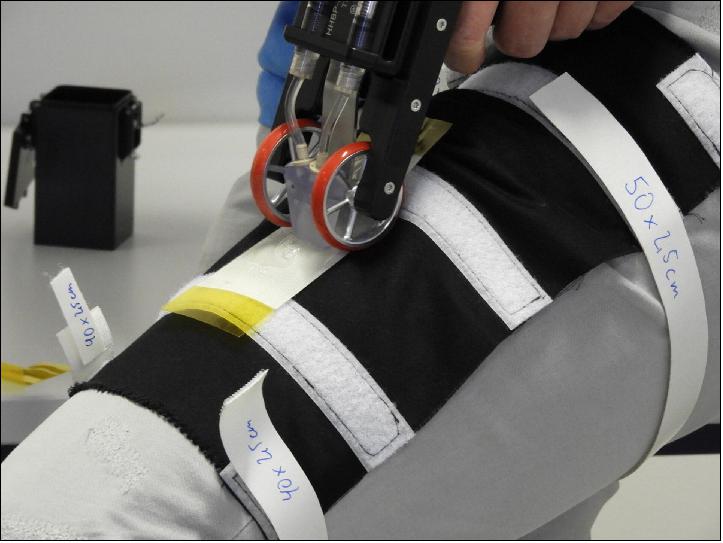
The Hard Stuff
Next on the list is another ESA-sponsored DLR experiment: Concrete Hardening, an investigation into how gravity affects the hardening process and properties of concrete.
Previous research showed differences in porosity and microstructure of concrete samples in microgravity. However, this was limited to the solidification of pure cement. In this study, the crew will mix cement, sand, or Moon dust simulant, plus additives with water and leave these to harden in weightlessness. Back on Earth scientists will examine the microstructure and mechanical strength of the samples mixed and hardened in orbit.
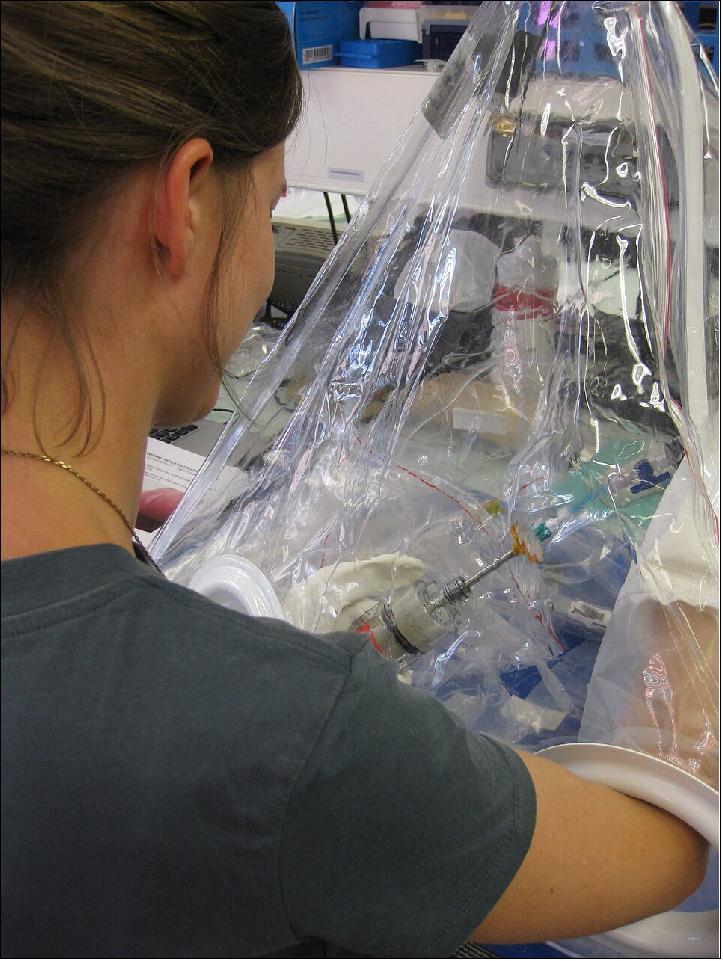
Spotlight on Cellular Function
The Cytoskeleton experiment investigates the internal machinery of human cells in microgravity to expand our knowledge of cellular function. It does so with a focus on Rho family GTPases.
These molecules control many important cellular pathways including cell proliferation, apoptosis (a form of programmed cell death), gene expression and intercellular organisation. It is believed that weightlessness can disturb the way Rho family GTPases function and the signalling they control.
Cytoskeleton tests two cell types: the fibroblast cell line WI-26, and the osteoblast cell line MG63. These two cell types are important for the body’s structure, with fibroblasts producing proteins, such as collagen – the main component of connective tissue – and osteoblasts responsible for bone formation.
Results of this study could help maintain optimal crew health and performance during spaceflight, and feed into clinical medical research on the ground by enabling scientists to examine cells in a way that is not possible on Earth.
Astro Pi
The Astro Pi mark II payload is a like for like upgrade and replacement for the original Astro Pi hardware that flew to the ISS in 2015 for ESA astronaut Tim Peake’s Principia mission.
They are two COTS Raspberry Pi 4B computers enclosed in aerospace grade aluminum cases with a range of integrated environmental sensors and a 12-megapixel camera for Earth Observation. ESA astronaut Samantha Cristoforetti explores the upgraded Astro Pis in this hardware reveal video.
One Astro Pi will be deployed in the Columbus module while the other will be looking through a hatch window towards the Earth. Students in European schools who are participating in the European Astro Pi Challenge can control these computers using the python programming language. By submitting their python programs their experiments are run on board the Station with the generated results and science data returned to ground for them to analyse.
Compose Components
Wireless Compose-2 is a technology demonstrator that aims to provide a flexible and adaptable wireless network infrastructure to conduct and execute low-power, low-weight, and wireless experiments on the International Space Station (ISS). Building on technology used for DLR’s first Wireless Compose technology demonstrator in 2018, it shows the capabilities of Wireless Networks for scientific, localisation, and medical experiments in the Columbus module.
Hardware for Wireless Compose-2 consists of five modules that together weigh just one kilogram. Each individual module is roughly the size of a small smartphone. The network will be a platform for other experiments including the Ballistocardiography for Extraterrestrial Applications and long-Term missions (BEAT) experiment that uses a t-shirt equipped with sensors to measure an astronaut’s ballistocardiographic data, including pulse and blood pressure.
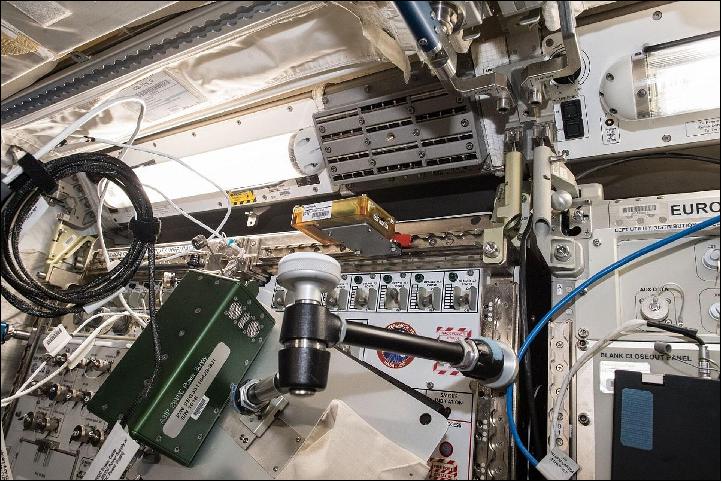
Space Age
Funded by the UK Space Agency, Microage will see synthetic muscle cells the size of a grain of rice sent for examination in orbit. A proportion of these cells will be electrically stimulated to induce contractions under microgravity conditions, while others are exposed to artificial gravity via centrifugation. Samples will be frozen and returned to Earth to help identify the mechanisms by which muscle mass is lost and possible modes of prevention.
More Instore
This is just a slither of the science winging its way to the Station inside the belly of a Dragon. Other European cargo includes components for Materials Science Lab (MSL) batch 3a, the European Drawer Rack (EDR-2) and Biolab, CalliopEO and ESA’s Ice Cubes facility for commercial research in Columbus.
STP-H8 (Space Test Program Houston 8) - Two Technology Instruments of the USSF for the ISS
• November 2, 2021: Two instruments launching to the International Space Station in a few weeks could be weather-forecasting game changers. The two novel instruments are expected to demonstrate that while they are much smaller, much lighter, and much less expensive than weather satellites orbiting today, they can collect some of the same essential data. 7)
The objective of the COWVR (Compact Ocean Wind Vector Radiometer) instrument is to measure the direction and speed of winds at the ocean surface. The TEMPEST (Temporal Experiment for Storms and Tropical Systems) instrument looks at atmospheric humidity.
Designed and built at NASA’s Jet Propulsion Laboratory in Southern California, the two instruments are technology demonstrations. NASA will archive the data and make it available to all interested users, but the main purpose of the mission is to prove the instruments can operate in space and supply data for weather forecasts. Together, they’re part of a U.S. Space Force (USSF) mission called Space Test Program-Houston 8 (STP-H8), expected to launch to the space station on 21 December 2021.
COWVR (Compact Ocean Wind Vector Radiometer)
Almost a decade in the making, COWVR grew from the space-based weather-forecasting and environmental observation programs of U.S. Department of Defense (DoD). The military collects data to forecast ocean surface winds with a spaceborne instrument named WindSat, launched in 2003.
A microwave radiometer, WindSat measures naturally occurring microwaves emitted from Earth’s atmosphere and surface. Over the ocean, when wind increases and waves grow larger, microwave emissions also increase. A microwave radiometer records these changing emissions, and processing the data can reveal both the speed and the direction of winds at the ocean surface. Those measurements are critical for monitoring how storms such as hurricanes develop, and they feed into forecasts and warnings to coastal populations and ships at sea.
WindSat has far exceeded its projected life span and is still operating, but in 2012, the Air Force began work on a replacement radiometer of the same sort, intending to launch the new instrument before WindSat went out of service. The expense and difficulty of building this type of instrument got DoD scientists thinking about what a next-generation ocean wind sensor could be. That’s where NASA came in.
Shannon Brown, a JPL engineer, had been working on a microwave radiometer for the oceanographic mission Jason-3, developed by NASA, the National Oceanic and Atmospheric Administration, and European partners to measure sea surface height. Brown recognized that the Jason-3 instrument’s design advances could be repurposed to meet the needs of weather forecasters. “We put a concept together that used most of the Jason-3 hardware designs, and we found it could measure wind speed and direction at a much lower cost than what the Air Force was building,” he said.
The novel aspect of COWVR is its simplified design. The WindSat radiometer rotates about 30 times a minute as it gathers data. The engineering challenge of developing and powering up parts that can rotate many millions of times in space has proven to be one of the most expensive and demanding aspects of radiometer development.
COWVR reduces the number of moving parts, replacing hardware with algorithms newly developed for the instrument by Brown and his colleagues. The algorithms tease the desired signals of wind speed and direction out of the raw data stream. Parts that still must rotate are now housed on a turntable so they don’t need to be powered individually. The streamlined instrument weighs only 130 pounds (58.7 kg) and uses 47 watts of power to operate – about as much as a bedside lamp – where WindSat weighs 990 pounds (450 kg) and uses 350 watts.
A team of NASA scientists and engineers began developing the instrument in 2013 at JPL with a budget of $24 million – one-fifth the cost of WindSat. They completed COWVR on budget and on schedule in 27 months, aiming for a planned launch in 2018. “It took a really talented team to do that,” Brown pointed out. “We had to use everyone’s best engineering judgment to keep moving forward.”
Don Boucher, principal scientist in the chief architect’s office of the U.S. Space Force (which took over space operations from the Air Force this year), monitored the project for the military. “COWVR has the distinct possibility of being an absolute game changer for our users,” he said. “It’s simpler to build, simpler to test, the timeframe to build the instrument is less – so you can build more of them for the same amount of money as one conventional radiometer. That has tremendous implications for our supply chain.”
When the planned 2018 launch didn’t pan out, the Air Force turned to the Space Test Program, which provides launches to the space station for the military science and engineering community. The space station orbit will give COWVR a view of the ocean surface at different times of day on each orbit, compared with a Sun-synchronous orbit that carries a satellite over any part of globe at the same time each day. Over time, this will aid understanding of how ocean waves develop and change throughout the day.

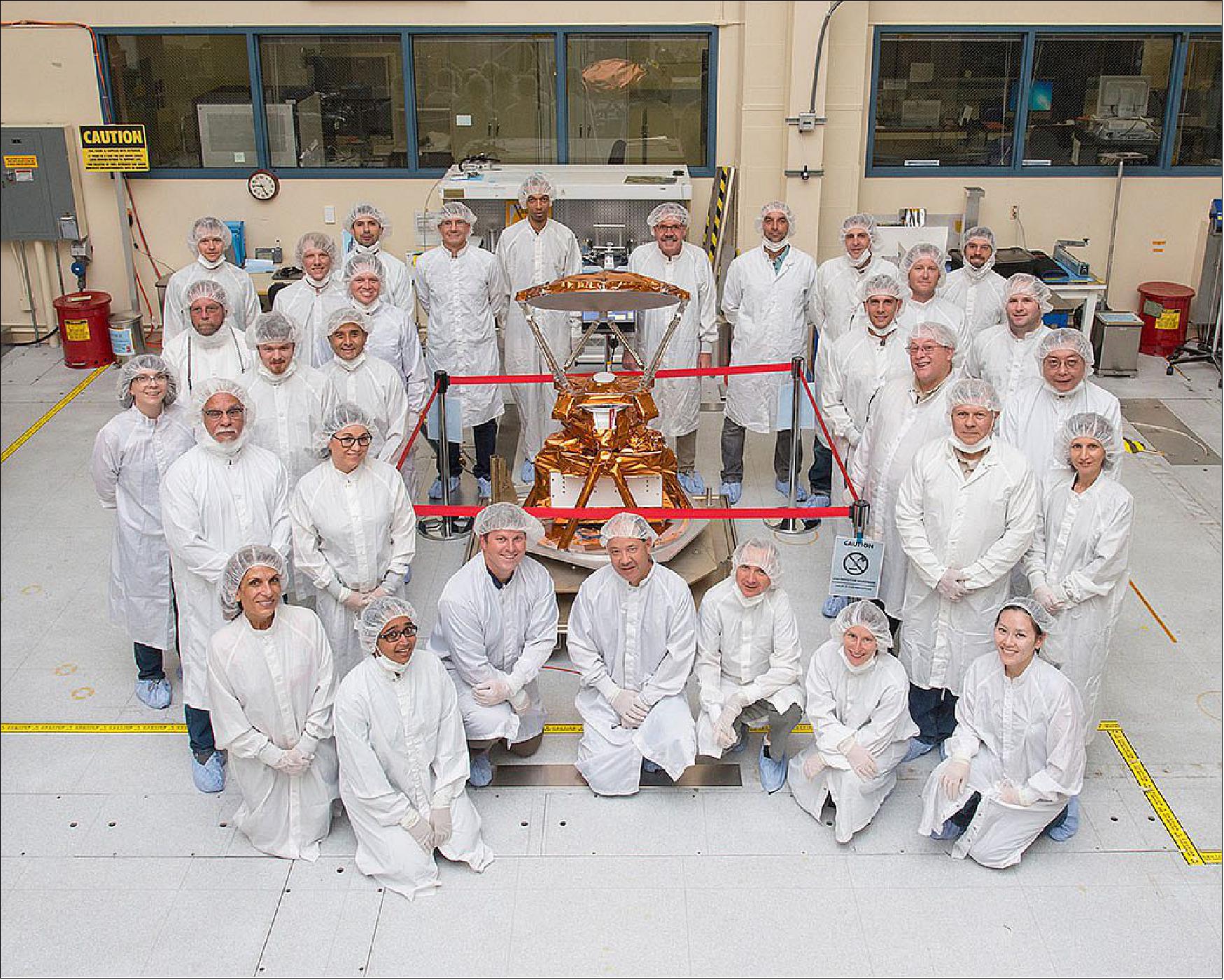
TEMPEST (Temporal Experiment for Storms and Tropical Systems)
“The Navy is really interested in monitoring tropical cyclone intensity, but that was one of the things we couldn’t design into COWVR because we had a very compressed schedule,” JPL’s Brown said. But JPL had an instrument already built for just that purpose: TEMPEST. About the size of a cereal box, it was a flight spare – a duplicate created in case of damage or other problems with a spaceborne instrument – for the TEMPEST-D 2018 NASA technology demonstration mission.
TEMPEST, too, is a microwave radiometer, but instead of winds, it measures microwave wavelengths that are sensitive to the presence of water vapor. Collecting data on multiple hurricanes and other storms between 2018 and last June, it had already demonstrated that it could measure water vapor at several levels of the atmosphere as well as the heritage satellites do.
“TEMPEST brings to the table an ability to sense both the amount of atmospheric moisture and its vertical distribution,” said Steve Swadley, the lead for calibration and validation of microwave sensors at the U.S. Naval Research Laboratory in Monterey, California. “This is important both for numerical models and for characterizing the moisture surrounding tropical cyclones. So when Shannon [Brown] told us, ‘We have a spare TEMPEST – would that be useful on this mission?’ the answer was an emphatic yes.”
If the instruments operate as expected, the lower-priced new technology is likely to see widespread use. Organizations would be able to launch four or five satellites on the same budget that formerly would have paid for one. Currently, there are so few weather satellites that only one or two of them may pass over a growing storm in an entire day. Those few “snapshots” of a storm don’t give forecasters enough information to monitor the kind of explosive growth that so many storms now exhibit. More satellites will give scientists a chance to increase the accuracy of forecasts and save more lives.
But that’s looking far ahead, Brown noted. The STP-H8 mission is still a technology demonstration to show the feasibility of the instruments. “We have no reason to think we won’t meet our objectives, but whatever comes out of it, we’re confident that we’re going to learn a lot.”
Launched on 21 December 2021 to the space station on the CRS-24 flight of SpaceX, the COWVR and TEMPEST instruments could lead the way to big improvements in gathering key information for weather forecasting. 8)

Here are Five Things to Know About COWVR and TEMPEST
1) They Aim to Collect the Same High-Quality Data as Their Much Larger Predecessors
Together, COWVR and TEMPEST will provide many of the data points that scientists use to produce weather and climate forecasts: They’ll measure not only the speed and direction of winds blowing over the ocean surface, but also precipitation, atmospheric moisture, how that moisture is distributed vertically, and other conditions at the ocean surface and in the atmosphere.
From 2003 to 2020, these types of measurements were acquired by the 450 kg Windsat instrument aboard the U.S. Department of Defense’s Coriolis satellite. Windsat lasted well beyond its anticipated lifespan. If COWVR and TEMPEST prove they’re up to the task, they (and small instruments like them) will be able to take the place of larger, aging satellites without compromising on data quality.
2) They Have the Potential to Improve Storm Forecasts
COWVR and TEMPEST will be attached to the space station, which circles our planet in low-Earth orbit from west to east about 16 times per day. Because of the station’s unique orbit, the two instruments will spend most of their time over the mid-latitudes and tropics – areas prone to storms – and revisit them more frequently than sensors in other orbits. The additional data will help scientists better understand storm formation and better track developing storm systems.
COWVR and TEMPEST will also be able to send the data back to Earth faster than some other instruments currently in use, enabling scientists and forecasters to monitor the rapid intensification many storms undergo – in near real time. “Most satellites communicate with just a few ground stations around the world, and that takes time,” said Shannon Brown, principal investigator for COWVR based at JPL. “The data could be a couple of hours old before it’s even on the ground, and then it still needs to be processed.”
COWVR and TEMPEST will also be able to send the data back to Earth faster than some other instruments currently in use, enabling scientists and forecasters to monitor the rapid intensification many storms undergo – in near real time. “Most satellites communicate with just a few ground stations around the world, and that takes time,” said Shannon Brown, principal investigator for COWVR based at JPL. “The data could be a couple of hours old before it’s even on the ground, and then it still needs to be processed.”
COWVR and TEMPEST will instead send their data back to Earth via NASA’s tracking and data relay satellite (TDRS) constellation. “TDRS essentially provides a direct data stream. So, once the sensors pass over a big hurricane or cyclone, you’re going to get that data instantly,” Brown said. “It’ll be up-to-the-minute observations, which is something not usually available with the traditional approach” – and something that could save lives.
3) Their Comprehensive Data May Improve Weather and Climate Model Predictions
The frequency with which COWVR and TEMPEST will take measurements over areas within their orbit will allow them to collect more comprehensive data than other instruments – data that is expected to reduce uncertainties in weather and climate models.
“The current satellite sensors that measure wind speed and direction at the ocean surface are in Sun-synchronous orbits, meaning that they provide measurements at a given location only in the morning and in the evening, leaving gaps in between,” said JPL’s Tony Lee, co-lead of the mission’s science working group. “The space station’s orbit will allow COWVR and TEMPEST to take measurements across different times of day, reducing those gaps.”
Weather and climate models use this type of data to make predictions. The more data that is available, the more accurate the models – and the predictions based on them – will be.
4) They’ll Shed Light on How Air-Sea Interactions Affect Weather and Climate
The amount of heat and moisture released by the ocean influences atmospheric conditions; likewise, atmospheric conditions, such as wind, influence ocean currents and heat distribution. The more scientists learn about these interactions, the better they’ll understand how they affect weather in the short term and climate in the long term.
Getting suitable data to study these interactions can be tricky, though.
If successful, COWVR and TEMPEST could change that. COWVR’s main purpose is to measure the speed and direction of wind at the ocean surface, and TEMPEST’s is to provide the atmospheric water vapor measurements. Since they’re flying together and taking measurements over the same areas, they’ll be able to acquire this complementary data at the same time.
“Simultaneous measurements of the different variables alleviate the difficulty associated with sampling time differences that come from mixing measurements from different satellites at different times,” Lee said. It will also enable them to account for interactions that happen at shorter time scales – wind gusts stirring up the ocean and causing it to lose heat to the atmosphere, for example.
5) They’ll Pave the Way for Future Satellite Constellations
If COWVR and TEMPEST perform well, they’ll prove that comprehensive data vital to weather forecasting and a better understanding of climate can be obtained in a much smaller package with a much smaller price tag than previously thought.
Because the instruments are smaller and cheaper, organizations could launch three or four small satellites for the same cost as one of the larger variations. A constellation of these small satellites would be able to take measurements of a given area – such as over a developing storm – far more frequently than a corresponding single satellite could, resulting in even further refinement of weather models and forecasts.
Arrival and Some Activities of the CRS-24 Crew at the ISS - Some Results (In Reverse Order)
• February 8, 2022: After being installed on the ISS, two small instruments designed and built at NASA/JPL were powered up Jan. 7 and began collecting data on Earth’s ocean winds and atmospheric water vapor – critical information required for weather and marine forecasts. Within two days, the Compact Ocean Wind Vector Radiometer (COWVR) and Temporal Experiment for Storms and Tropical Systems (TEMPEST) instruments had gathered enough data to begin producing maps. 9)
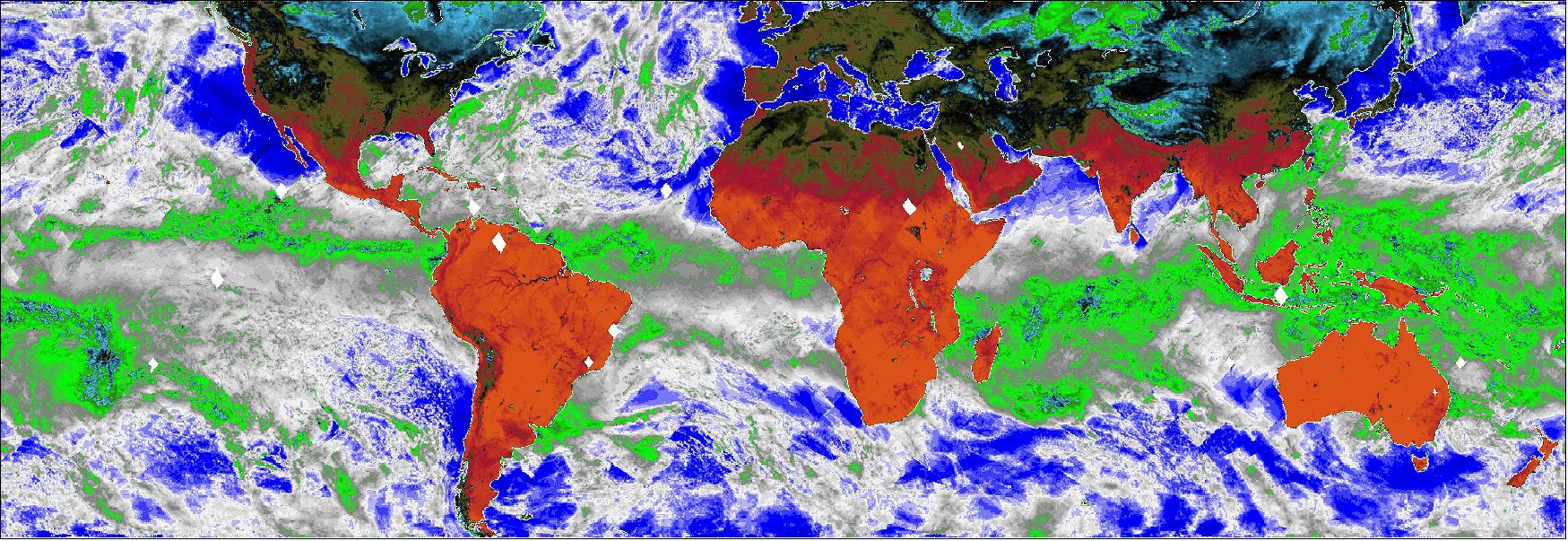
- Part of the U.S. Space Force’s Space Test Program-Houston 8 (STP-H8), the instruments were designed to demonstrate that they can collect data comparable in quality to the larger instruments currently operating in orbit.
- This new map from COWVR shows microwave emissions from Earth at 34 GHz through all latitudes visible to the space station (±52º ). This particular microwave frequency provides weather forecasters information on the strength of winds at the ocean surface, the amount of water in clouds, and the amount of water vapor in the atmosphere.
- Green and white on the map indicate higher water vapor and clouds, while dark blue over the ocean indicates drier air and clear sky. The image captures typical weather patterns, such as tropical moisture and rain (the green band stretching across center of map) and mid-latitude storms moving across the ocean.
- "We’re off to a great start,” said Shannon Brown, the JPL technologist who designed the COWVR instrument. “Seeing this quality of data so early into the mission sets the stage for very exciting things to come.”
- COWVR is a complete rethinking of a classic instrument design, while TEMPEST is the product of a long advance toward miniaturizing instrument components. If they continue to prove successful, they will crack open the door to a new era where lower-cost satellites complement the existing weather satellite fleet.
• February 3, 2022: ESA's new Astro PIs were launched to the ISS on 21 December 2021 and are now fully operational! 10)
- The Astro Pis completed a commissioning process performed by technical experts on-ground along with ESA astronaut, Matthias Maurer, on the ISS. Some of their new functionalities were tested, giving us the opportunity to show you the very first pictures they took of Earth!

- After the successful launch of our new Astro Pis (phew!), the computers were received on-station by ESA Astronaut Matthias Maurer, who performed a series of steps to prepare them for work.
- Once the Astro Pis were set-up, each took a turn in the Node 2 nadir window, where they ran a program to collect a batch of images using their new cameras and lenses.

- The teams participating in Astro Pi Mission Space Lab 2021-22 will receive a collection of these images, which can be used, if needed, to train a machine learning model and to get an understanding of the type of pictures they can expect to see when their own experiments result come in May 2022.
• February 2, 2022: NASA and SpaceX are investigating the delayed opening of a parachute on a cargo Dragon spacecraft that recently returned to Earth, an incident similar to one that took place on a Crew Dragon spacecraft last year. 11)

- NASA confirmed Feb. 2 that the cargo Dragon spacecraft that splashed down off the Florida coast Jan. 24, concluding the CRS-24 space station resupply mission, suffered a delayed opening of one of its four main parachutes but still allowed the capsule to safely land.
- “During the return of the SpaceX CRS-24 mission, teams observed a single main parachute that lagged during inflation like the return of the Crew-2 mission,” agency spokesman Josh Finch said in a statement to SpaceNews. “The vertical descent rate of both flights was within the system design margins at splashdown, and all four main parachutes fully opened prior to splashdown on both missions.”
- The Crew-2 Crew Dragon spacecraft, which splashed down Nov. 8, also had a parachute that was slow to open. NASA and SpaceX quickly cleared the Crew-3 mission to launch Nov. 10 after concluding that the parachute issue did not pose a safety risk.
- Bill Gerstenmaier, vice president of build and flight reliability at SpaceX and a former head of human spaceflight at NASA, said at a Nov. 9 briefing that the delayed parachute opening was a “known condition” seen in some previous tests. “We don’t see anything that’s off-nominal that concerns us from a parachute standpoint,” he said then.
- NASA and SpaceX are reviewing the parachute data ahead of the Crew-4 launch, scheduled for mid-April, and the subsequent return of the Crew-3 Crew Dragon spacecraft currently at the station. A commercial Crew Dragon flight to the International Space Station, Axiom Space’s Ax-1 mission, is scheduled for launch March 30, returning before the Crew-4 launch.
- “As partners, NASA and SpaceX jointly review the imagery data and perform physical inspection of the drogue and main parachutes after flight. The inflation model also continues to be updated to better characterize and understand margins and splashdown conditions,” Finch said in the statement. “This review of flight data and parachute performance models will be completed prior to the launch of the Crew-4 mission and the return of Crew-3 astronauts from the International Space Station.”
- NASA had not previously disclosed the parachute issue involving the CRS-24 mission, but one of the agency’s leaders hinted at it last week. “We’ve seen a couple of delayed parachute delays now on the fourth chute with cargo vehicles returning and one crew vehicle,” NASA Associate Administrator Bob Cabana said during a “safety stand-down” event at NASA Headquarters Jan. 27, the agency’s Day of Remembrance.
- His comments were in response to a question about “normalization of deviance,” a concept where organizations ignore data that is out of normal bounds because it did not cause an immediate safety issue but which could post a longer-term hazard. Normalization of deviance was a factor in both the shuttle Challenger and Columbia accidents.
- “We need to make sure we understand the model that we have, that we’re OK as we go forward,” Cabana said. “That’s going to require a little looking into and not just accepting that, well, it’s OK, nothing bad happened.”
Seeking More Transparency
- Unlike splashdowns of Crew Dragon craft, neither NASA nor SpaceX provide coverage of cargo Dragon spacecraft splashdowns. Those cargo Dragon splashdowns originally took place in the Pacific Ocean, hundreds of kilometers from the California coast, making coverage logistically difficult.
- However, the lack of coverage continued even after cargo Dragon splashdowns moved to just off the Florida coast, the same location used for Crew Dragon splashdowns. NASA and SpaceX limited their coverage of the CRS-24 splashdown Jan. 24 to tweets and blog posts, without any photos or video. A NASA “Space to Ground” video about ISS activities, published Jan. 28, mentioned the splashdown but used file images from previous Dragon splashdowns.
- Some NASA advisers have complained about a lack of public information about agency operations, including human spaceflight. Wayne Hale, chair of the NASA Advisory Council’s Human Exploration and Operations Committee, mentioned it during a Jan. 18 meeting of his committee.
- “There is a real thirst out there for better understanding of what the agency is doing and, for some reason, the organization can’t seem to push that out the way we used to back in the shuttle days,” he said. “There seems to have been a marked decrease in the information flow. That bothers me a lot.”
• January 25, 2022: A U.S. resupply ship completed its 24th International Space Station cargo mission after returning to Earth on Monday afternoon. Meanwhile, back in space the Expedition 66 crew had hearing tests while working on a myriad of orbiting lab and science maintenance tasks. 12)

- The SpaceX Cargo Dragon space freighter parachuted to a splashdown off the coast of Florida carrying over 4,900 pounds of science experiments and station hardware on Monday at 4:05 p.m. EST. The commercial cargo craft undocked from the Harmony module’s space-facing port on Sunday at 10:40 a.m. completing a 32-days attached to the space station.
- On Tuesday, three astronauts participated in a pair of different hearing studies. Flight Engineer Matthias Maurer of ESA (European Space Agency) kicked off his day working on the Audio Diagnostics study to measure how station noise levels impact an astronaut’s hearing. At the end of their day, NASA Flight Engineers Mark Vande Hei and Raja Chari took part in a hearing assessment as part of regularly scheduled exams.
- Continuous orbital maintenance is necessary to keep the station and its multitude of systems in tip-top shape. NASA astronaut Kayla Barron worked on transferring water into tanks, then searched for a camera pan tilt unit for the Mission Control based Inventory and Stowage Officer before cleaning up the U.S. Quest airlock after spacesuit battery work. NASA Flight Engineer Thomas Marshburn organized cables in the U.S. Destiny laboratory module before making space inside the Leonardo permanent multipurpose laboratory module ahead of an upcoming U.S. cargo mission.
- Over in the Russian segment of the station, Commander Anton Shkaplerov participated in a human research study to determine the effectiveness of exercising in weightlessness. Roscosmos Flight Engineer Pyotr Dubrov assisted the commander during the exercise study then worked on European Robotic Arm computer systems inside the Nauka multipurpose laboratory module.
• January 24, 2022: SpaceX’s upgraded Dragon cargo spacecraft splashed down at 4:05 p.m. EST off the Florida coast, marking the return of the company’s 24th contracted cargo resupply mission to the International Space Station for NASA. The spacecraft carried more than 4,900 pounds (2222 kg) of valuable scientific experiments and other cargo back to Earth. 13)
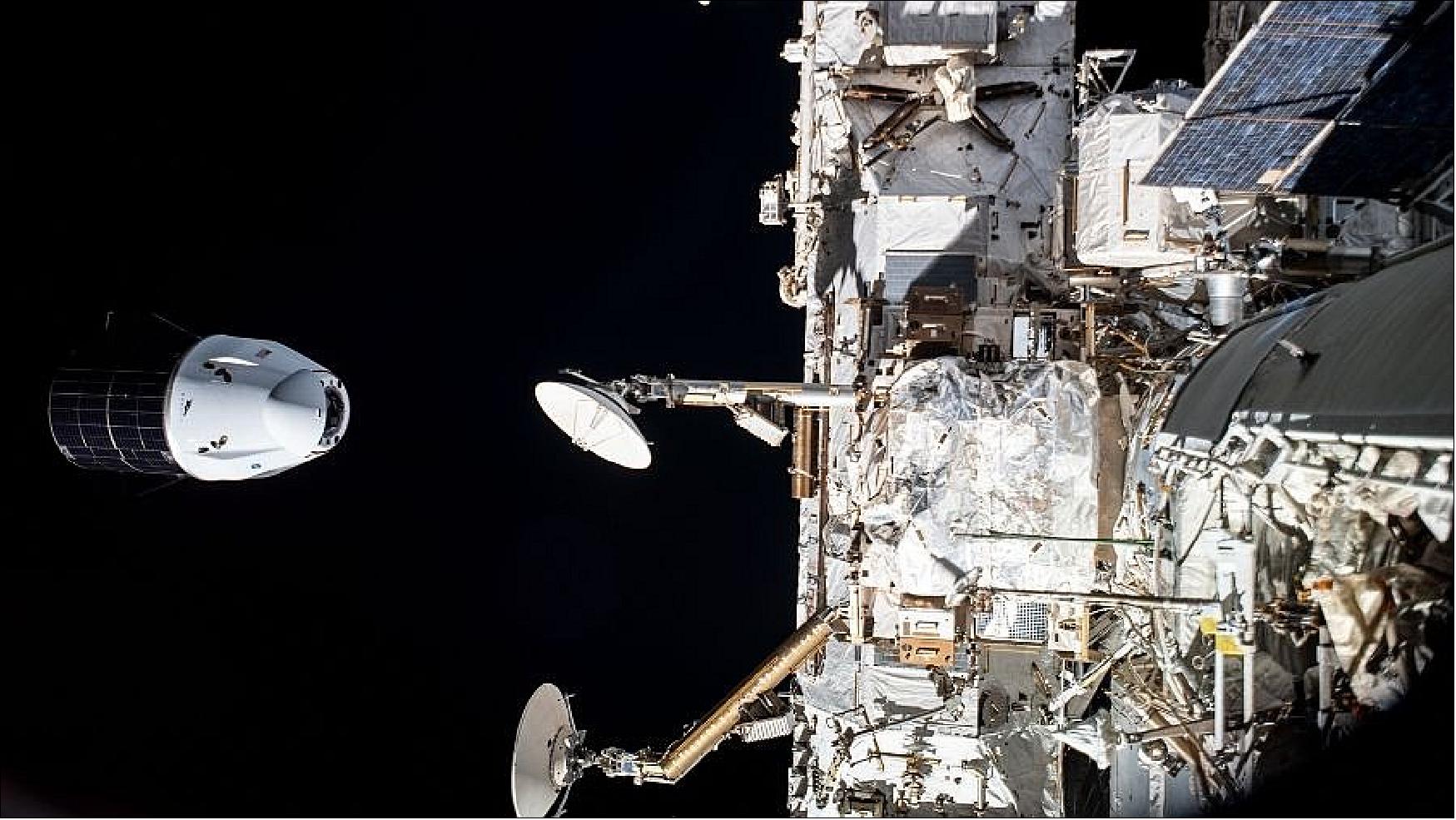
- Splashing down off the coast of Florida enables quick transportation of the experiments to NASA’s Space Station Processing Facility at the agency’s Kennedy Space Center in Florida, allowing researchers to collect data with minimal sample exposure to Earth’s gravity.
Some of the Scientific Investigations that Dragon will Return to Earth Include
- Last light: A state-of-the-art light imaging microscope, the Light Microscopy Module (LMM) will return after about 12 years on the station. LMM, sponsored by NASA’s Division of Biological and Physical Sciences, made it possible to observe and record the way matter is organized and moves on the microscopic level, and supported ground-breaking colloid research, plant studies, and thermophysics experiments.
- Tiny structures, assemble: The InSPACE-4 physics study is returning samples that could provide insight into how to harness nanoparticles to fabricate and manufacture new materials, including medical diagnostics and thermal shields for Earth and space applications.
- Cell signaling in microgravity: The ESA (European Space Agency) investigation Cytoskeleton contributes to understanding of how the human body responds to microgravity. The study could support development of countermeasures to help astronaut crew members maintain optimum health on future space missions.
• January 19, 2022: Russian cosmonauts Anton Shkaplerov and Pyotr Dubrov of Roscosmos concluded their spacewalk at 2:28 p.m. EST after 7 hours and 11 minutes. 14)
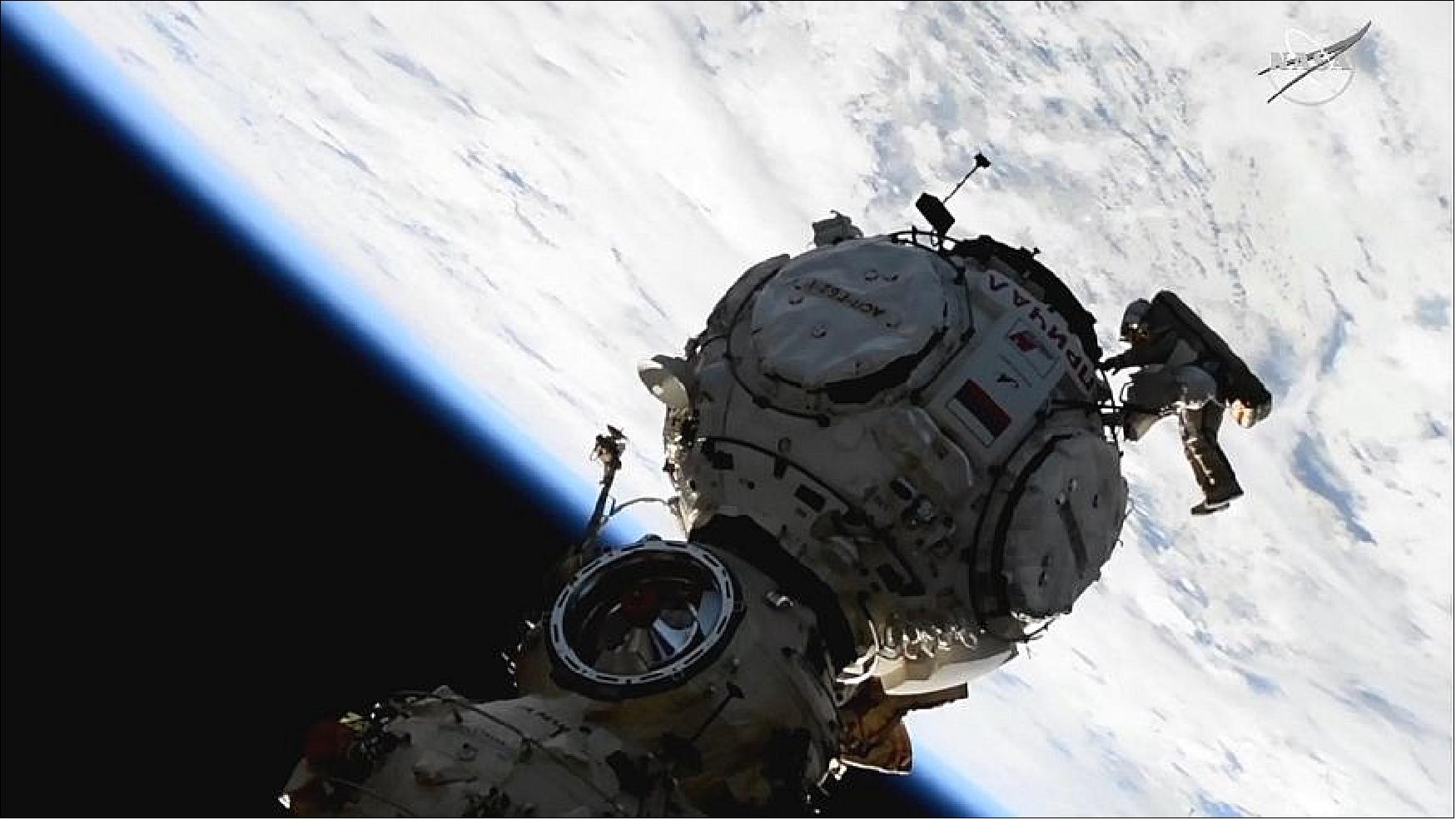
- Shkaplerov and Dubrov completed their major objectives for today to ready the new Prichal module for future Russian visiting spacecraft. The cosmonauts installed handrails, rendezvous antennas, a television camera, and docking targets on Prichal, which automatically docked to the Nauka multipurpose laboratory module in November.
- This was the first spacewalk this year and the 246th overall in support of space station assembly, maintenance and upgrades. Spacewalkers have now spent a total of 64 days, 19 hours, and 37 minutes working outside the station.
- This was the third spacewalk in Shkaplerov’s career, who has now spent a total of 21 hours and 39 minutes spacewalking, and the fourth for Dubrov, bringing his total to 29 hours and 49 minutes of spacewalk time.
- Additional spacewalks are planned this spring to outfit a European robotic arm on the Nauka laboratory and to activate Nauka’s airlock for future spacewalk activity.
• January 19, 2022: Expedition 66 Commander Anton Shkaplerov and Flight Engineer Pyotr Dubrov of Roscosmos began a spacewalk to ready the new Prichal module for future Russian visiting spacecraft when they opened the hatch of the Poisk docking compartment airlock of the International Space Station at 7:17 a.m. EST. 15)
- Coverage of the spacewalk continues on NASA Television, the NASA app, and the agency’s website.
- Shkaplerov, designated extravehicular crew member 1 (EV1), is wearing a Russian Orlan spacesuit with red stripes, and Dubrov is wearing a spacesuit with blue stripes as extravehicular crew member 2 (EV2).
- Views from a camera on Shkaplerov’s helmet are designated with the number 22, and Dubrov’s is labeled with the number 16.
- The duo’s primary tasks for today’s spacewalk are to install handrails, rendezvous antennas, a television camera, and docking targets on Prichal, which automatically docked to the Nauka multipurpose laboratory module in November.
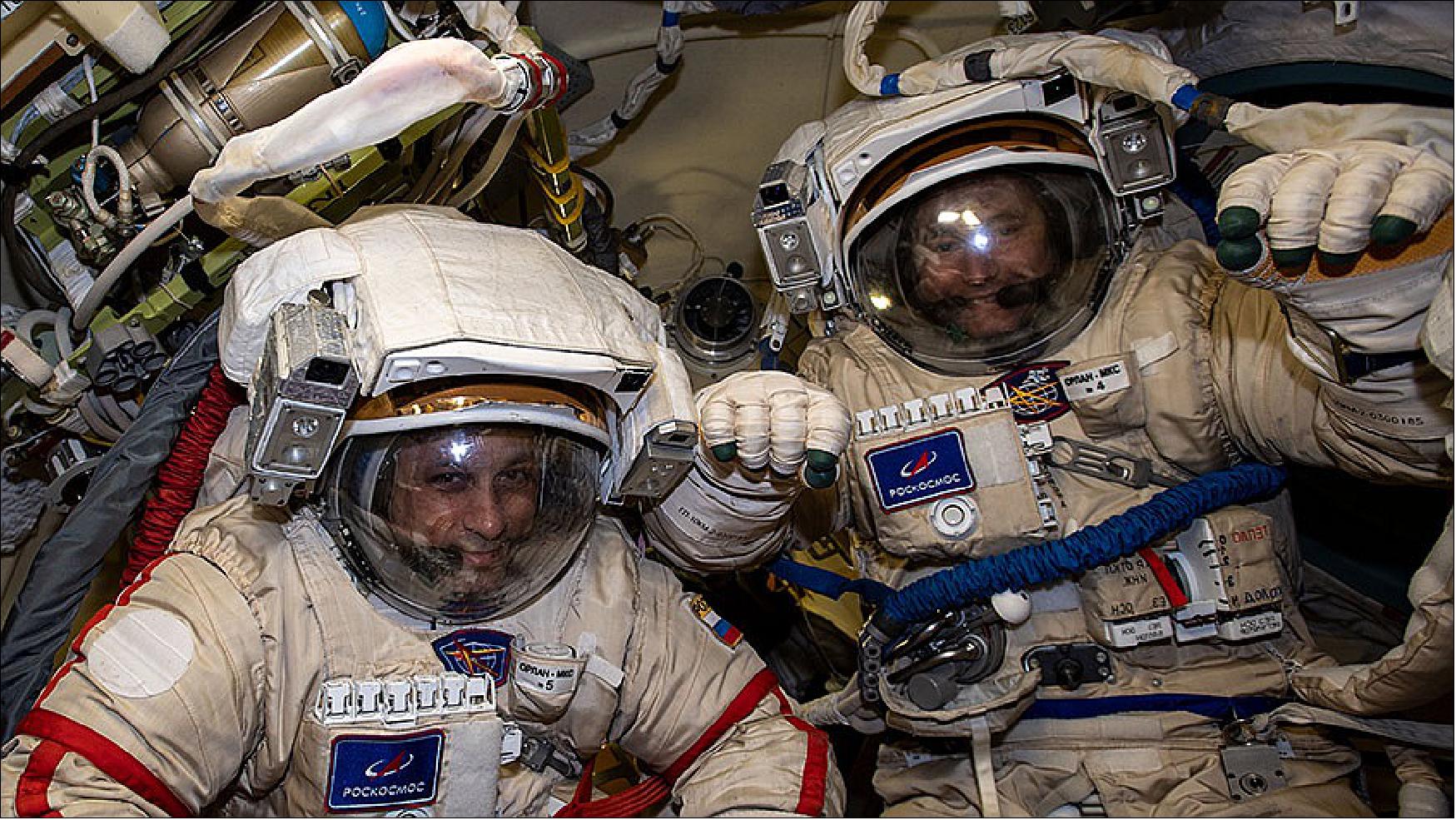
• January 17, 2022: Immerse yourself in 360° of science with ESA astronaut Matthias Maurer as he prepares an experiment to examine how human cells behave in weightlessness. 16)
- The Cytoskeleton experiment is a biological study that aims to determine the changing function of RhoGTPases when in vitro cell cultures are exposed to weightlessness. It will run in the Biolab facility of Europe’s Columbus laboratory.
• January 12, 2022: In one week the first spacewalk of 2022 is set begin at the International Space Station. Two Expedition 66 crew members are getting their spacesuits ready as the rest of the crew works research and maintenance. 17)
- Station Commander Anton Shkaplerov and Flight Engineer Pyotr Dubrov are due to exit the Poisk module in their Russian Orlan spacesuits on Jan. 19 at 7 a.m. EDT. They will spend about seven hours configuring both the Prichal docking module and the Nauka multipurpose laboratory module in the vacuum of space.
- Both cosmonauts continued setting up and attaching components to their spacesuits on Wednesday. NASA Flight Engineer Mark Vande Hei, who will assist the spacewalkers next week, joined the pair during the afternoon and reviewed the Poisk airlock depressurization/repressurization timeline.
- The station’s other crew members focused on space physics, life science and lab maintenance. NASA Flight Engineer Raja Chari started his day working on hardware maintenance for the Ring Sheared Drop experiment then took a robotics test for a behavioral study. Astronaut Matthias Maurer of ESA (European Space Agency) continued collecting microbe samples swabbed from station surfaces for analysis.
- NASA astronaut Kayla Barron collected microbe samples from the station’s atmosphere then took samples from a carbon dioxide removal system for analysis. At the end of the day, Vande Hei gathered equipment ahead of operations planned for station fluid systems.
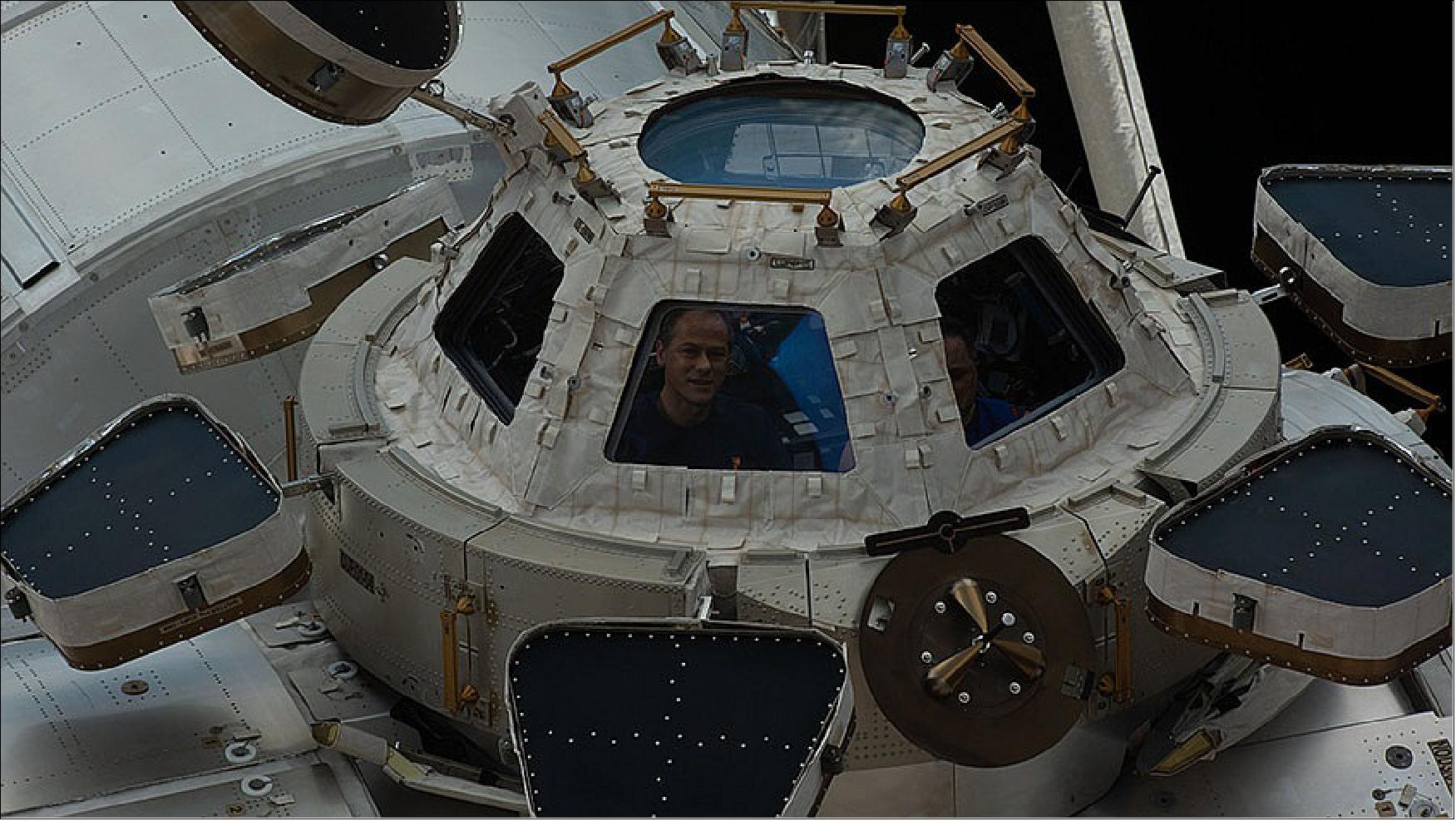
• January 5, 2022: Space biology work and science hardware maintenance and were the main research goals for the Expedition 66 crew aboard the International Space Station on Wednesday. The orbital residents also checked out life support gear and worked on cargo transfers. 18)
- Three NASA astronauts, Mark Vande Hei, Thomas Marshburn and Kayla Barron, joined each other in the Kibo laboratory module during the afternoon and set up external research components. Vande Hei installed the Multi-Purpose Experiment Platform (MPEP) in Kibo’s airlock that will later be placed outside in the vacuum of space. Marshburn and Barron assisted with the MPEP installation work ahead of tiny satellites, or CubeSats, being deployed from the device into Earth orbit.
- Marshburn then joined NASA Flight Engineer Raja Chari for vein scans in the Columbus laboratory module. Chari once again led the biomedical activities as crew medical officer using the Ultrasound 2 device to scan Marshburn’s neck, shoulder, and leg veins. Doctors on Earth monitor the health checks in real time to gain insight into how long-term microgravity affects the human body.
- Barron also tended to the oxygen generation system before analyzing microbe samples collected from inside BEAM, the Bigelow Expandable Activity Module. Flight Engineer Matthias Maurer of ESA (European Space Agency) installed the ANITA-2 cabin air analyzer then inspected the Muscle Atrophy Research Exercise System ahead of upcoming new component work.
- Commander Anton Shkaplerov worked throughout Wednesday in the station’s Russian segment on electronics maintenance on cargo transfers from the ISS Progress 79 resupply ship. Shkaplerov also spent some time on a study researching how international crews and mission controllers relate during a long-duration spaceflight. Flight Engineer Pyotr Dubrov spent most of the day installing payload interface controller units while also finding time for immunity system research work.

• January 04, 2022: Crew Dragon proficiency checks were on the schedule for a pair of NASA astronauts aboard the International Space Station on Tuesday (Jan. 4). Eye checks, space biology research, and spacewalk preparations also kept the Expedition 66 crew busy throughout the day. 19)
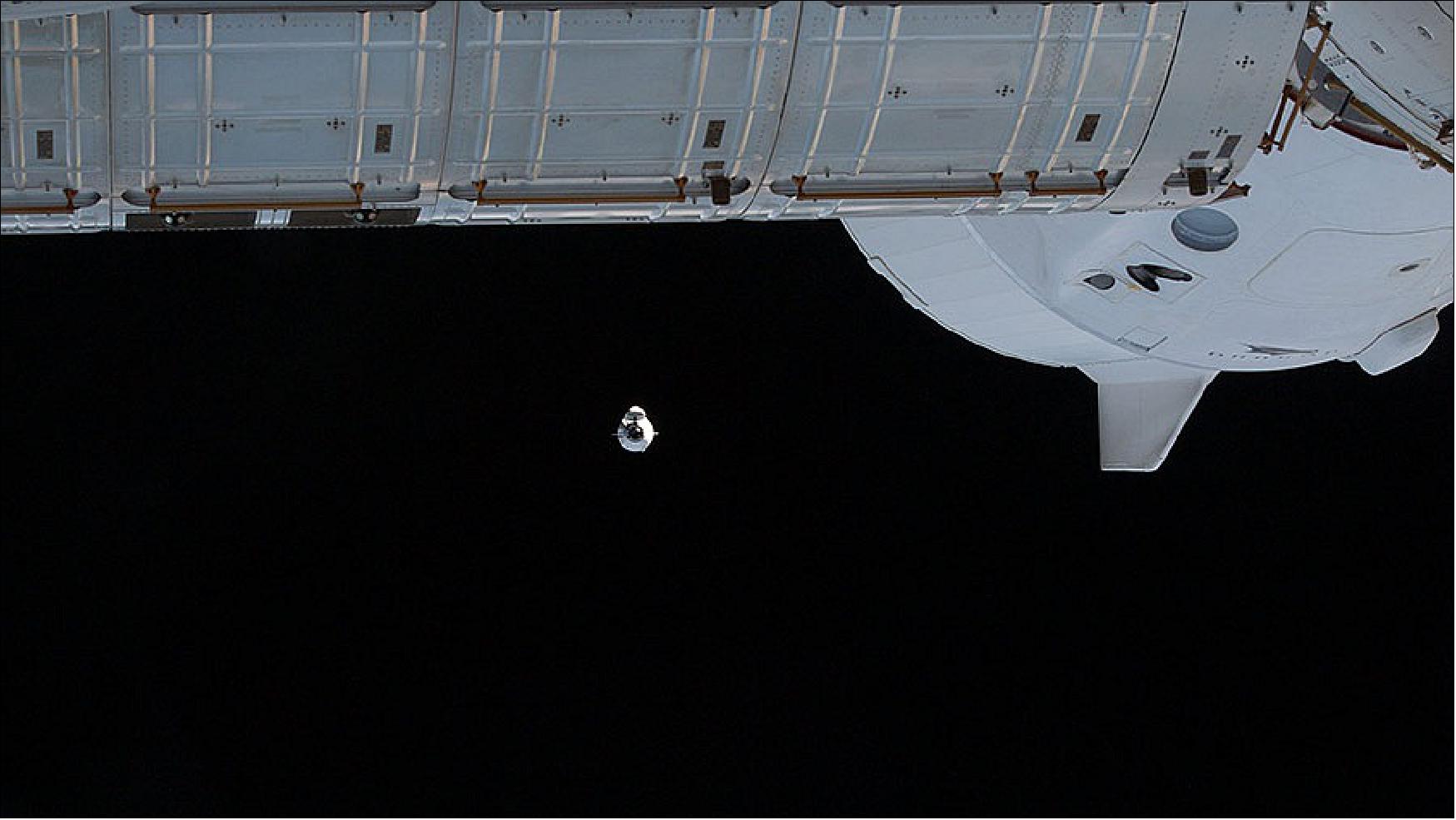
- The SpaceX Crew Dragon Endeavour, which delivered four astronauts to the orbiting lab, has been docked to the Harmony module’s forward port since Nov. 11, 2021. The Crew Dragon’s commander and pilot, Raja Chari and Thomas Marshburn, both station flight engineers, practiced and familiarized themselves with deorbit and landing procedures in Endeavour today. The duo will return to Earth, along with Kayla Barron of NASA and Matthias Maurer of ESA (European Space Agency), aboard the Crew Dragon in the spring.
- Chari and Barron earlier joined each other Tuesday morning for vein scans. Chari took charge as crew medical officer and scanned the veins in Barron’s neck, shoulder and legs with the Ultrasound 2 device. Chari later partnered with Marshburn for eye checks and retina scans using medical imaging gear. Doctors on the ground monitored the vein and eye scans in real time. The regularly scheduled health checks provide researchers insight into how microgravity affects the human body long term.
- NASA Flight Engineer Mark Vande Hei documented his meals today to understand how nutrition affects space health. The veteran astronaut, who will be on the station for nearly a year, also serviced a variety of science hardware to ensure ongoing research operations. Maurer continued setting up the Cytoskeleton space biology study that will explore how the human cell’s internal machinery adapts to weightlessness. The ESA astronaut later assisted Chari and Barron with retinal scans then stowing the eye imaging gear.
- Cosmonauts Anton Shkaplerov and Pyotr Dubrov are moving right along with their preparations for a spacewalk planned for Jan. 19. The pair from Roscosmos continued collecting and organizing the spacewalk tools they will use to finish configuring and connecting Nauka multipurpose laboratory module to the station’s Russian segment. They are scheduled to work for seven-and-a-half hours outside in the vacuum of space inside their Russian Orlan spacesuits.
- Nauka will serve as a new science facility, docking port, and spacewalk airlock for future operations.
• December 22, 2021: While the International Space Station was traveling more than 260 miles over the South Pacific Ocean, a SpaceX Dragon cargo spacecraft autonomously docked to the space-facing side of the orbiting laboratory’s Harmony module at 3:41 a.m. EST (08:41 UTC), Wednesday, Dec. 22. NASA astronauts Raja Chari and Thomas Marshburn were monitoring docking operations for Dragon. 20)
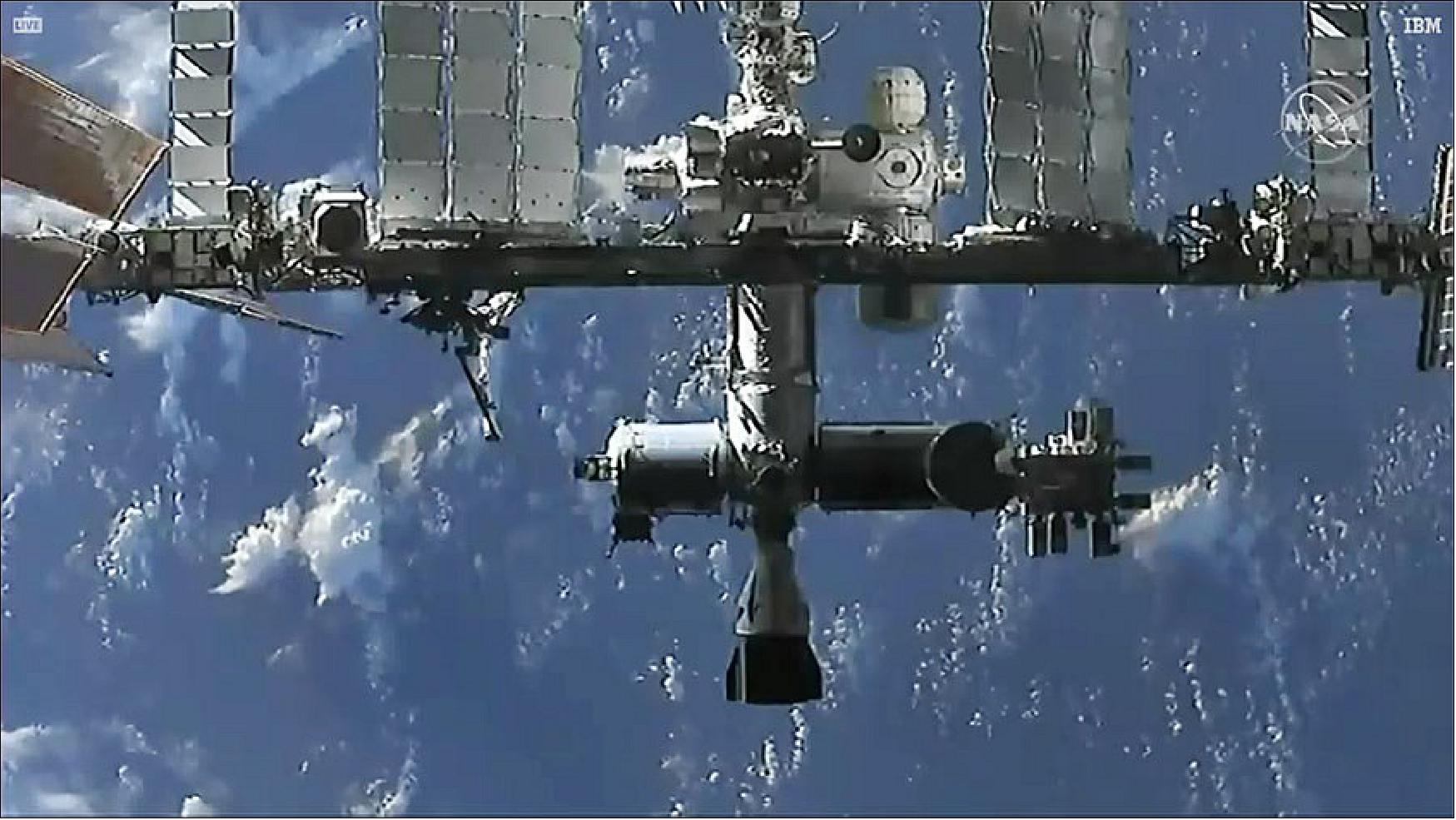
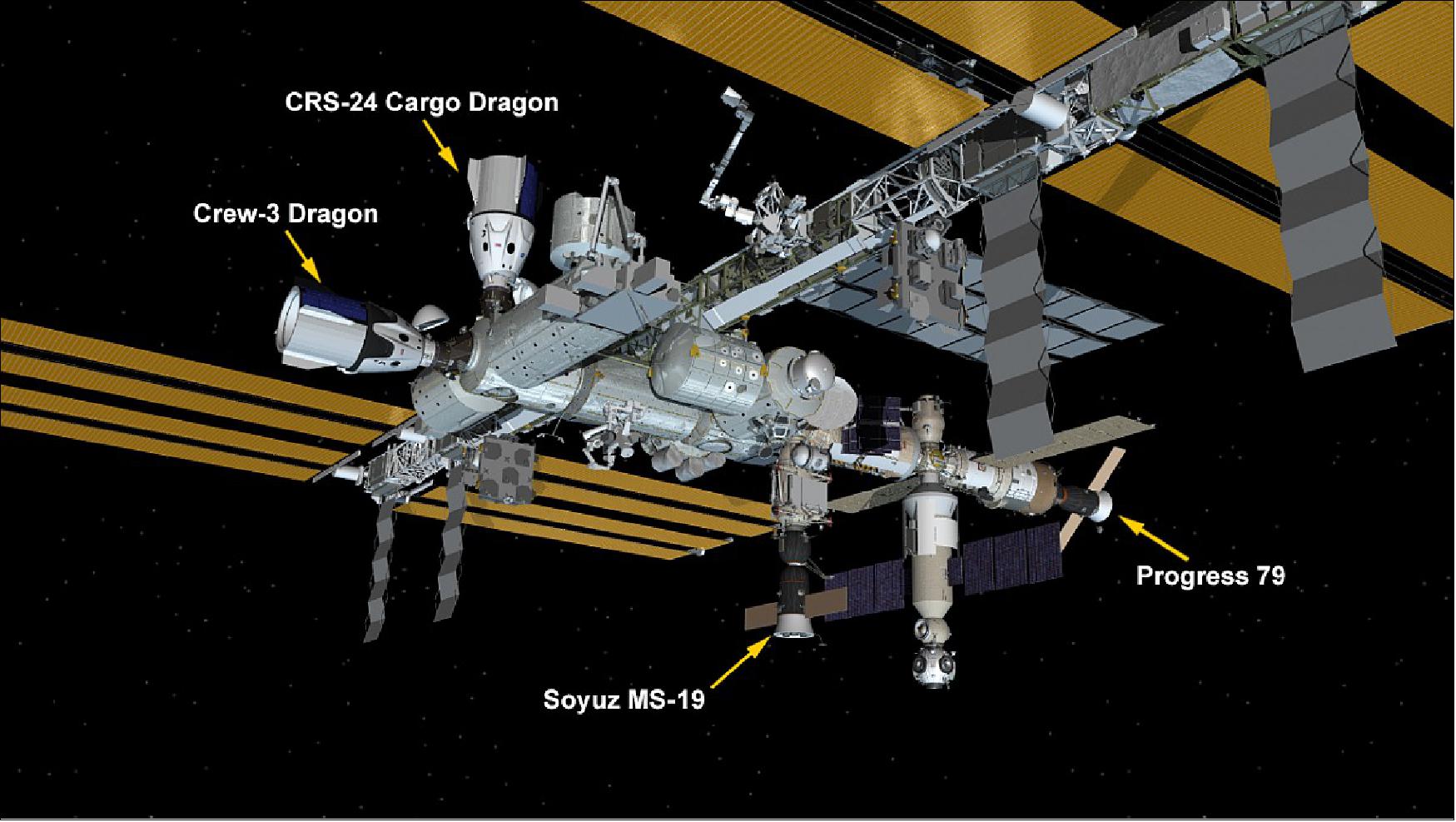
Cargo Highlights 21)
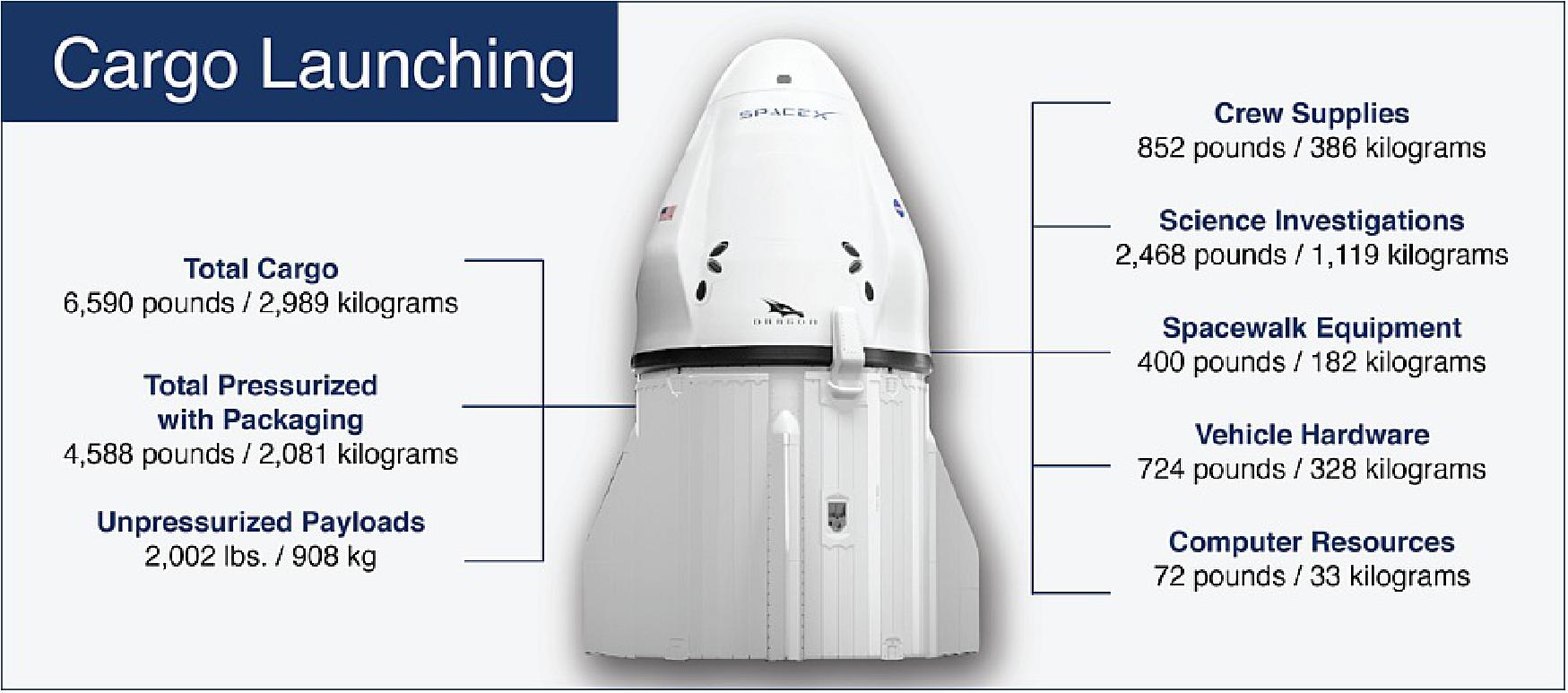
Hardware
• Compact Ocean Wind Vector Radiometer (COWVR) - This instrument will launch in the trunk of Dragon and measure the direction and speed of winds at the ocean surface.
• Temporal Experiment for Storms and Tropical Systems (TEMPEST) - This instrument will launch in the trunk of Dragon and will investigate atmospheric humidity.
• Hydrogen Sensor - Critical environmental control and life support system hardware that monitors for the presence of excess hydrogen in generated oxygen, which helps inform NASA of warnings signs with the oxygen generator system’s cell stack.
• Advanced Resistive Exercise Device (ARED) Knowledge Reaper Asset in a Kinetic Network (KRAKN) Electronics Box - This electronics box will upgrade the advanced resistive exercise device’s legacy instrumentation box and will be utilized on-orbit by the crew members to support their exercise needs.
• Remote Power Control Module (RPCM) Type V Internal - Planned to replace a degraded unit currently installed, this RPCM Type V Internal supports the overall Electronic Power System by distributing power capabilities across the ISS.
• Fridge - Following a failure of an on-orbit Fridge unit, this spare Fridge will provide the required cold stowage facility capability on-orbit to support multiple investigations during Expeditions 66 and 67.
• EXPRESS Flowmeters - These critical spares measure the flow rates and provide a signal to command corresponding control valves for the EXPRESS (which stands for Expedite the Processing of Experiments to the Space Station) racks on-orbit, providing necessary capabilities to payload investigations.
• Rodent Research Hardware - Rodents, habitats, transporters, and support hardware required for the rodent-specific research mission during the SpaceX-24 duration.
References
1) ”Detergent, Skin Bioprinter Launch on NASA’s SpaceX Resupply Mission,” NASA Press Release 21-173, 21 December 2021, URL: https://www.nasa.gov/press-release/
detergent-skin-bioprinter-launch-on-nasa-s-spacex-resupply-mission
2) ”NASA Sets Coverage, Invites Public to Virtually Join Next Cargo Launch,” NASA Press Release, 15 December 2021, URL: https://www.nasa.gov/press-release/
nasa-sets-coverage-invites-public-to-virtually-join-next-cargo-launch-1
3) Jeff Foust, ”Falcon 9 launches cargo Dragon, lands 100th booster,” SpaceNews, 21 December 2021, URL: https://spacenews.com/falcon-9-launches-cargo-dragon-lands-100th-booster/
4) ”SpaceX CRS-24 Mission Overview,” ISS National Laboratory, 13 December 2021, URL: https://www.issnationallab.org/iss360/spacex-crs-24-mission-overview/
5) Jason Costa, ”ELaNa 38 CubeSats: Small Satellites Making a Big Impact,” NASA KSC, 17 December 2021, URL: https://blogs.nasa.gov/kennedy/2021/12/
17/elana-38-cubesats-small-satellites-making-a-big-impact/
6) ”Dragon delivery – European science destined for space,” ESA Science & Exploration, 20 December 2021, URL: https://www.esa.int/Science_Exploration/
Human_and_Robotic_Exploration/Dragon_delivery_European_science_destined_for_space
7) ”Small but Mighty NASA Weather Instruments Prepare for Launch,” NASA/JPL, 2 November 2021, URL: https://www.jpl.nasa.gov/news/small-but-mighty-nasa-weather-instruments-prepare-for-launch?
utm_source=iContact&utm_medium=email&utm_campaign=nasajpl&utm_content=daily20211103-1
8) Jane J. Lee, Ian J. O’Neill, Esprit Smith, ”5 Things to Know About a Pair of Small But Mighty Weather Instruments,” NASA/JPL News, 21 December 2021, URL: https://www.jpl.nasa.gov
/news/5-things-to-know-about-a-pair-of-small-but-mighty-weather-instruments
9) Carol Rasmussen, ”New Space-Based Weather Instruments Start Gathering Data,” NASA/JPL News, 8 February 2022, URL: https://www.jpl.nasa.gov/news/
new-space-based-weather-instruments-start-gathering-data?utm_source=iContact&
utm_medium=email&utm_campaign=nasajpl&utm_content=daily20220208-1
10) ”Our brand-new Astro Pis are now ready for students' experiments!,” ESA Education, 3 February 2022, URL: https://www.esa.int/Education/AstroPI/
Our_brand-new_Astro_Pis_are_now_ready_for_students_experiments
11) Jeff Foust, ”NASA and SpaceX investigating delayed Dragon parachute opening,” SpaceNews, 2 February 2022, URL: https://spacenews.com/
nasa-and-spacex-investigating-delayed-dragon-parachute-opening/
12) Mark Garcia, ”Crew Hearing Checks, Lab Cleanup after Dragon Splashes Down,” NASA Space Station, 25 January 2022, URL: https://blogs.nasa.gov/spacestation/2022/
01/25/crew-hearing-checks-lab-cleanup-after-dragon-splashes-down/
13) Mark Garcia, ”Cargo Dragon Splashes Down Ending SpaceX CRS-24 Mission,” NASA Space Station, 24 January 2022, URL: https://blogs.nasa.gov/spacestation/2022/
01/24/cargo-dragon-splashes-down-ending-spacex-crs-24-mission/
14) Mark Garcia, ”Cosmonauts Wrap Up Spacewalk after Russian Module Work,” NASA Space Station, 19 January 2022, URL: https://blogs.nasa.gov/spacestation/2022/
01/19/cosmonauts-wrap-up-spacewalk-after-russian-module-work/
15) Mark Garcia, ”Russian Spacewalkers Exit Station to Service Russian Modules,” NASA Space Station, 19 January 2022, URL: https://web.archive.org/web/20220119203425/https://blogs.nasa.gov/spacestation/2022/01/19/russian-spacewalkers-exit-station-to-service-russian-modules/
16) ”Space science in 360º | Cosmic Kiss,” ESA Science & Exploration, 17 January, 2022, URL: https://www.esa.int/ESA_Multimedia/Videos/2022/01/Space_science_in_360_Cosmic_Kiss
17) Heidi Lavelle, ”Cosmonauts Prep for Spacewalk as Astronauts Work Science and Maintenance,” NASA Space Station, 12 January 2022, URL: https://blogs.nasa.gov/spacestation/2022/
01/12/cosmonauts-prep-for-spacewalk-as-astronauts-work-science-and-maintenance/
18) Mark Garcia,” Space Biology, Science Hardware Work Keeping Station Crew Busy,” NASA Stace Station, 5 January 2022, URL: https://blogs.nasa.gov/spacestation/2022/
01/05/space-biology-science-hardware-work-keeping-station-crew-busy/
19) Heidi Lavelle, Dragon Checks, Biology and Spacewalk Preps Fill Crew Day,” NASA Space Station, 4 January 2022, URL: https://blogs.nasa.gov/spacestation/2022/
01/04/dragon-checks-biology-and-spacewalk-preps-fill-crew-day/
20) Mark Garcia, ”Cargo Dragon Docks to Station with Brand New Science,” NASA Space Station, 22 December 2021, URL: https://blogs.nasa.gov/spacestation/2021
/12/22/cargo-dragon-docks-to-station-with-brand-new-science/
21) ”SpaceX CRS-24 Mission Overview,” NASA, URL: https://www.nasa.gov
/content/spacex-crs-24-mission-overview
The information compiled and edited in this article was provided by Herbert J. Kramer from his documentation of: ”Observation of the Earth and Its Environment: Survey of Missions and Sensors” (Springer Verlag) as well as many other sources after the publication of the 4th edition in 2002. - Comments and corrections to this article are always welcome for further updates (eoportal@symbios.space).